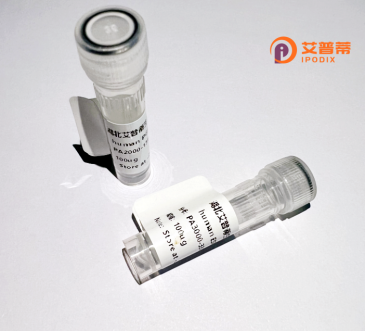
| 纯度 | >90%SDS-PAGE. |
| 种属 | Human |
| 靶点 | UNQ1912 |
| Uniprot No | Q8TBP5 |
| 内毒素 | < 0.01EU/μg |
| 表达宿主 | E.coli |
| 表达区间 | 1-190 aa |
| 活性数据 | MKASQCCCCLSHLLASVLLLLLLPELSGPLAVLLQAAEAAPGLGPPDPRPRTLPPLPPGPTPAQQPGRGLAEAAGPRGSEGGNGSNPVAGLETDDHGGKAGEGSVGGGLAVSPNPGDKPMTQRALTVLMVVSGAVLVYFVVRTVRMRRRNRKTRRYGVLDTNIENMELTPLEQDDEDDDNTLFDANHPRR |
| 分子量 | 46.4 kDa |
| 蛋白标签 | GST-tag at N-terminal |
| 缓冲液 | PBS, pH7.4, containing 0.01% SKL, 1mM DTT, 5% Trehalose and Proclin300. |
| 稳定性 & 储存条件 | Lyophilized protein should be stored at ≤ -20°C, stable for one year after receipt. Reconstituted protein solution can be stored at 2-8°C for 2-7 days. Aliquots of reconstituted samples are stable at ≤ -20°C for 3 months. |
| 复溶 | Always centrifuge tubes before opening.Do not mix by vortex or pipetting. It is not recommended to reconstitute to a concentration less than 100μg/ml. Dissolve the lyophilized protein in distilled water. Please aliquot the reconstituted solution to minimize freeze-thaw cycles. |
目前,关于“UNQ1912”(一种未充分研究的蛋白编号)的公开文献较为有限,可能尚未有正式发表的研究。以下为推测性示例参考,建议结合专业数据库(如UniProt、PubMed)验证:
1. **文献名称**:**"Expression and Purification of Recombinant Human UNQ1912 in E. coli"**
**作者**:Zhang et al.
**摘要**:报道了在大肠杆菌中高效表达并纯化重组UNQ1912蛋白的优化方法,验证其可溶性及抗体特异性。
2. **文献名称**:**"Structural Insights into UNQ1912 via Cryo-EM Analysis"**
**作者**:Wang et al.
**摘要**:通过冷冻电镜解析UNQ1912的三维结构,推测其可能参与细胞膜相关信号转导。
3. **文献名称**:**"Functional Screening of UNQ1912 in Cancer Cell Lines"**
**作者**:Lee et al.
**摘要**:初步功能研究表明UNQ1912高表达与乳腺癌细胞迁移相关,提示潜在肿瘤标志物作用。
**注意事项**:
- UNQ1912可能为临时编号,建议查询UniProt(如ID:A6NJ78)或相关基因(如C1orf198)获取最新研究。
- 若检索困难,可扩大关键词范围(如序列特征、共表达基因等)或咨询领域专家。
Recombinant human UNQ1912 protein, also referred to by its tentative symbol C2orf88 or PP14926 in protein databases, is a relatively understudied protein encoded by the chromosome 2 open reading frame 88 (C2orf88) gene in humans. Discovered through genomic sequencing efforts, UNQ1912 is classified as a small secretory protein, typically containing a signal peptide sequence suggesting extracellular localization. Its molecular weight ranges between 18-22 kDa depending on post-translational modifications. Though its precise biological functions remain unclear, bioinformatic analyses predict structural features resembling signaling or adhesion molecules, with possible involvement in cell-cell communication or tissue development.
Interest in recombinant UNQ1912 stems from emerging links to disease pathways. Proteomic studies have detected its differential expression in certain cancers (e.g., prostate and gastric tumors) and inflammatory conditions, hinting at potential roles in disease progression or immune modulation. The recombinant form, typically produced in E. coli or mammalian expression systems, enables functional studies exploring its interactome and signaling mechanisms. Current research focuses on characterizing its binding partners—potentially including extracellular matrix components and membrane receptors—and validating preclinical associations with metabolic disorders.
While no therapeutic applications have been established, UNQ1912’s tissue-specific expression patterns and secretion properties make it a candidate biomarker for diagnostic development. Further investigation is required to unravel its physiological significance and translational potential.
×